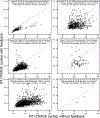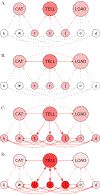Contra assertions, feedback improves word recognition: How feedback and lateral inhibition sharpen signals over noise
- PMID: 37944313
- PMCID: PMC11238470
- DOI: 10.1016/j.cognition.2023.105661
Contra assertions, feedback improves word recognition: How feedback and lateral inhibition sharpen signals over noise
Abstract
Whether top-down feedback modulates perception has deep implications for cognitive theories. Debate has been vigorous in the domain of spoken word recognition, where competing computational models and agreement on at least one diagnostic experimental paradigm suggest that the debate may eventually be resolvable. Norris and Cutler (2021) revisit arguments against lexical feedback in spoken word recognition models. They also incorrectly claim that recent computational demonstrations that feedback promotes accuracy and speed under noise (Magnuson et al., 2018) were due to the use of the Luce choice rule rather than adding noise to inputs (noise was in fact added directly to inputs). They also claim that feedback cannot improve word recognition because feedback cannot distinguish signal from noise. We have two goals in this paper. First, we correct the record about the simulations of Magnuson et al. (2018). Second, we explain how interactive activation models selectively sharpen signals via joint effects of feedback and lateral inhibition that boost lexically-coherent sublexical patterns over noise. We also review a growing body of behavioral and neural results consistent with feedback and inconsistent with autonomous (non-feedback) architectures, and conclude that parsimony supports feedback. We close by discussing the potential for synergy between autonomous and interactive approaches.
Keywords: Computational models; Language processing; Neural Networks; Spoken word recognition.
Copyright © 2023 Elsevier B.V. All rights reserved.
Figures





References
-
- Alain C, Arnott SR, & Picton TW (2001). Bottom–up and top–down influences on auditory scene analysis: Evidence from event-related brain potentials. Journal of Experimental Psychology: Human Perception and Performance, 27(5), 1072–1089. Retrieved from 10.1037/0096-1523.27.5.1072 doi: 10.1037/0096-1523.27.5.1072 - DOI - DOI - PubMed
MeSH terms
Grants and funding
LinkOut - more resources
Full Text Sources

